Leadership Reflection and Bill Gates Leadership Analysis Essay
VerifiedAdded on 2023/01/16
|11
|3658
|27
Essay
AI Summary
This essay delves into the multifaceted concept of leadership, beginning with a personal reflection on the author's experience within a team project. The reflection highlights the application of democratic and Laissez-faire leadership styles, discussing their effectiveness and limitations. The author identifies personal strengths in time management and communication, while acknowledging weaknesses in patience and problem-solving. An action plan for future development is outlined, focusing on enhancing creative thinking, building trust, and improving time management and problem-solving skills. The essay then transitions to an analysis of Bill Gates' leadership at Microsoft, examining his application of various leadership theories, including behavioral, situational, contingency, transformational, and transactional leadership. The analysis emphasizes Gates' visionary approach, adaptability, and impact on the computing industry, providing a comprehensive overview of leadership principles and practices. The essay concludes by highlighting the importance of adapting leadership styles to different situations and team members to drive organizational success.
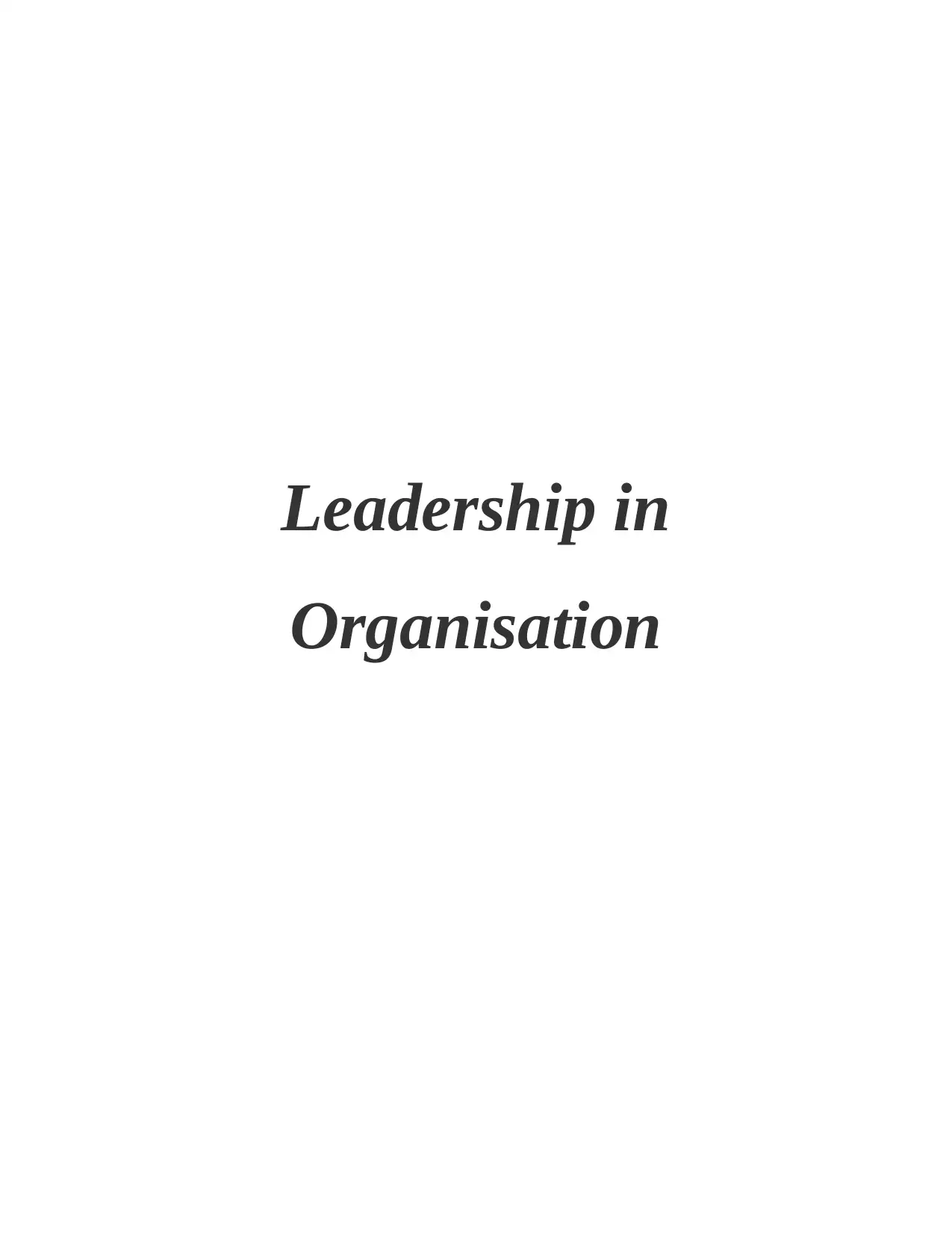
Leadership in
Organisation
Organisation
Paraphrase This Document
Need a fresh take? Get an instant paraphrase of this document with our AI Paraphraser
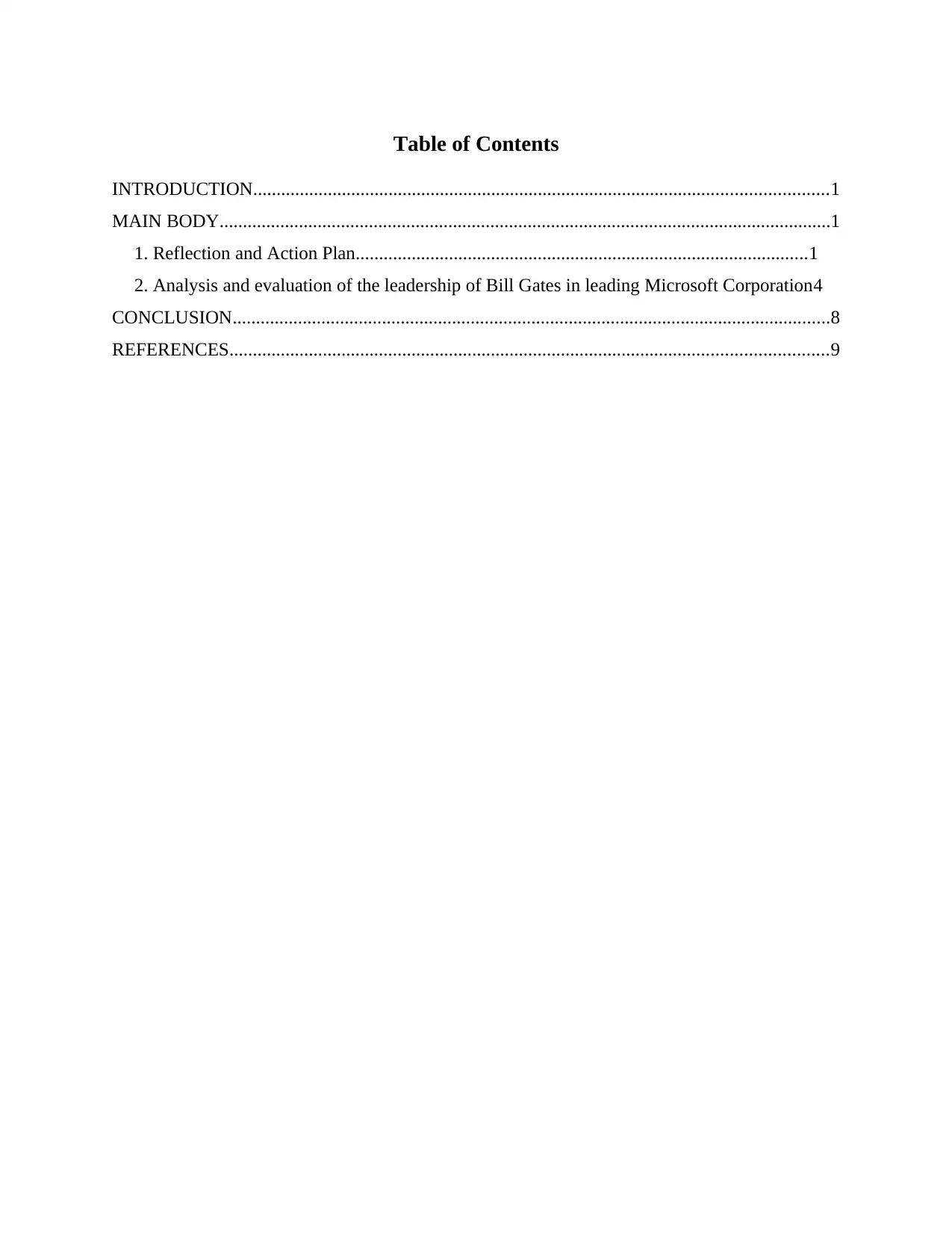
Table of Contents
INTRODUCTION...........................................................................................................................1
MAIN BODY...................................................................................................................................1
1. Reflection and Action Plan.................................................................................................1
2. Analysis and evaluation of the leadership of Bill Gates in leading Microsoft Corporation4
CONCLUSION................................................................................................................................8
REFERENCES................................................................................................................................9
INTRODUCTION...........................................................................................................................1
MAIN BODY...................................................................................................................................1
1. Reflection and Action Plan.................................................................................................1
2. Analysis and evaluation of the leadership of Bill Gates in leading Microsoft Corporation4
CONCLUSION................................................................................................................................8
REFERENCES................................................................................................................................9
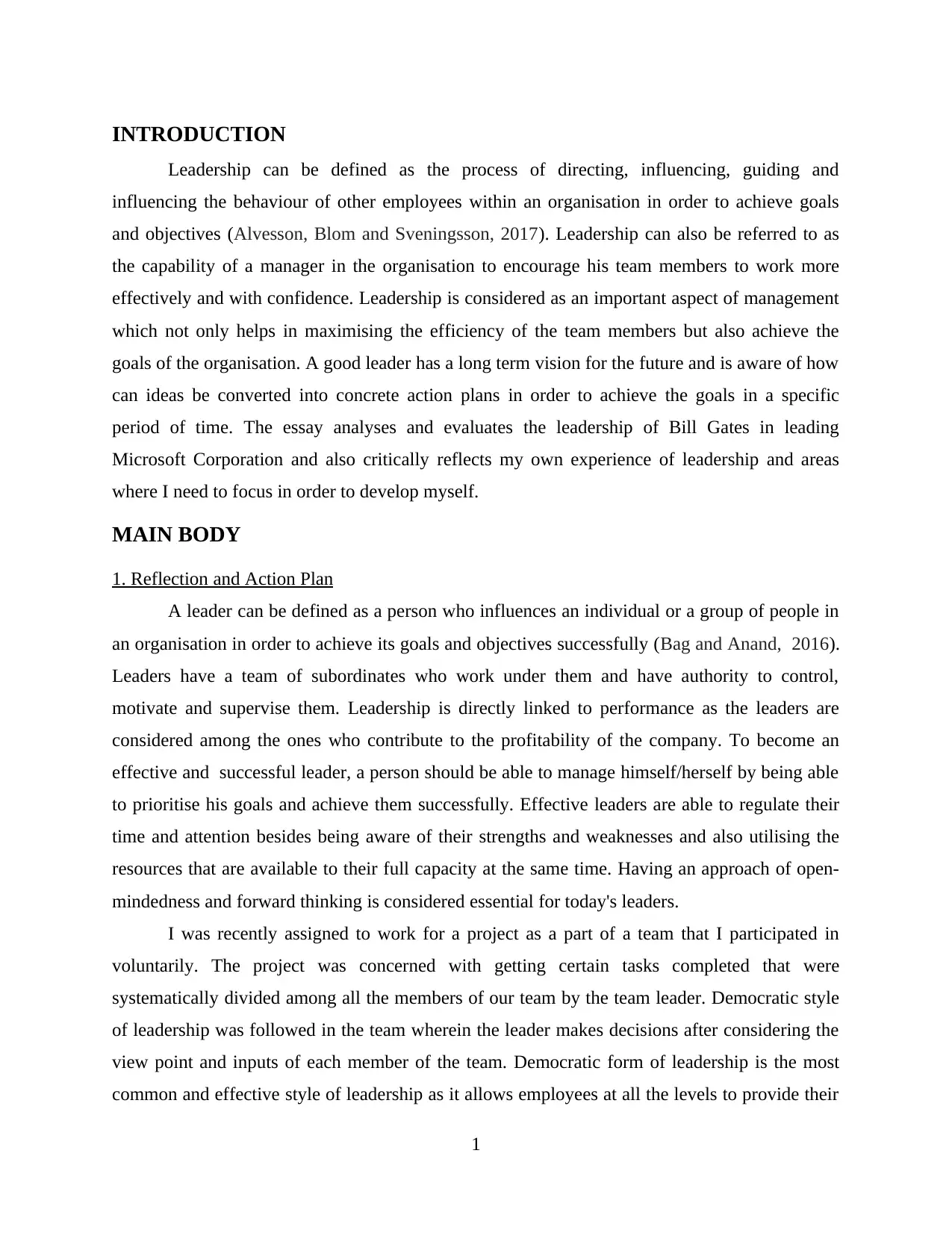
INTRODUCTION
Leadership can be defined as the process of directing, influencing, guiding and
influencing the behaviour of other employees within an organisation in order to achieve goals
and objectives (Alvesson, Blom and Sveningsson, 2017). Leadership can also be referred to as
the capability of a manager in the organisation to encourage his team members to work more
effectively and with confidence. Leadership is considered as an important aspect of management
which not only helps in maximising the efficiency of the team members but also achieve the
goals of the organisation. A good leader has a long term vision for the future and is aware of how
can ideas be converted into concrete action plans in order to achieve the goals in a specific
period of time. The essay analyses and evaluates the leadership of Bill Gates in leading
Microsoft Corporation and also critically reflects my own experience of leadership and areas
where I need to focus in order to develop myself.
MAIN BODY
1. Reflection and Action Plan
A leader can be defined as a person who influences an individual or a group of people in
an organisation in order to achieve its goals and objectives successfully (Bag and Anand, 2016).
Leaders have a team of subordinates who work under them and have authority to control,
motivate and supervise them. Leadership is directly linked to performance as the leaders are
considered among the ones who contribute to the profitability of the company. To become an
effective and successful leader, a person should be able to manage himself/herself by being able
to prioritise his goals and achieve them successfully. Effective leaders are able to regulate their
time and attention besides being aware of their strengths and weaknesses and also utilising the
resources that are available to their full capacity at the same time. Having an approach of open-
mindedness and forward thinking is considered essential for today's leaders.
I was recently assigned to work for a project as a part of a team that I participated in
voluntarily. The project was concerned with getting certain tasks completed that were
systematically divided among all the members of our team by the team leader. Democratic style
of leadership was followed in the team wherein the leader makes decisions after considering the
view point and inputs of each member of the team. Democratic form of leadership is the most
common and effective style of leadership as it allows employees at all the levels to provide their
1
Leadership can be defined as the process of directing, influencing, guiding and
influencing the behaviour of other employees within an organisation in order to achieve goals
and objectives (Alvesson, Blom and Sveningsson, 2017). Leadership can also be referred to as
the capability of a manager in the organisation to encourage his team members to work more
effectively and with confidence. Leadership is considered as an important aspect of management
which not only helps in maximising the efficiency of the team members but also achieve the
goals of the organisation. A good leader has a long term vision for the future and is aware of how
can ideas be converted into concrete action plans in order to achieve the goals in a specific
period of time. The essay analyses and evaluates the leadership of Bill Gates in leading
Microsoft Corporation and also critically reflects my own experience of leadership and areas
where I need to focus in order to develop myself.
MAIN BODY
1. Reflection and Action Plan
A leader can be defined as a person who influences an individual or a group of people in
an organisation in order to achieve its goals and objectives successfully (Bag and Anand, 2016).
Leaders have a team of subordinates who work under them and have authority to control,
motivate and supervise them. Leadership is directly linked to performance as the leaders are
considered among the ones who contribute to the profitability of the company. To become an
effective and successful leader, a person should be able to manage himself/herself by being able
to prioritise his goals and achieve them successfully. Effective leaders are able to regulate their
time and attention besides being aware of their strengths and weaknesses and also utilising the
resources that are available to their full capacity at the same time. Having an approach of open-
mindedness and forward thinking is considered essential for today's leaders.
I was recently assigned to work for a project as a part of a team that I participated in
voluntarily. The project was concerned with getting certain tasks completed that were
systematically divided among all the members of our team by the team leader. Democratic style
of leadership was followed in the team wherein the leader makes decisions after considering the
view point and inputs of each member of the team. Democratic form of leadership is the most
common and effective style of leadership as it allows employees at all the levels to provide their
1
⊘ This is a preview!⊘
Do you want full access?
Subscribe today to unlock all pages.

Trusted by 1+ million students worldwide
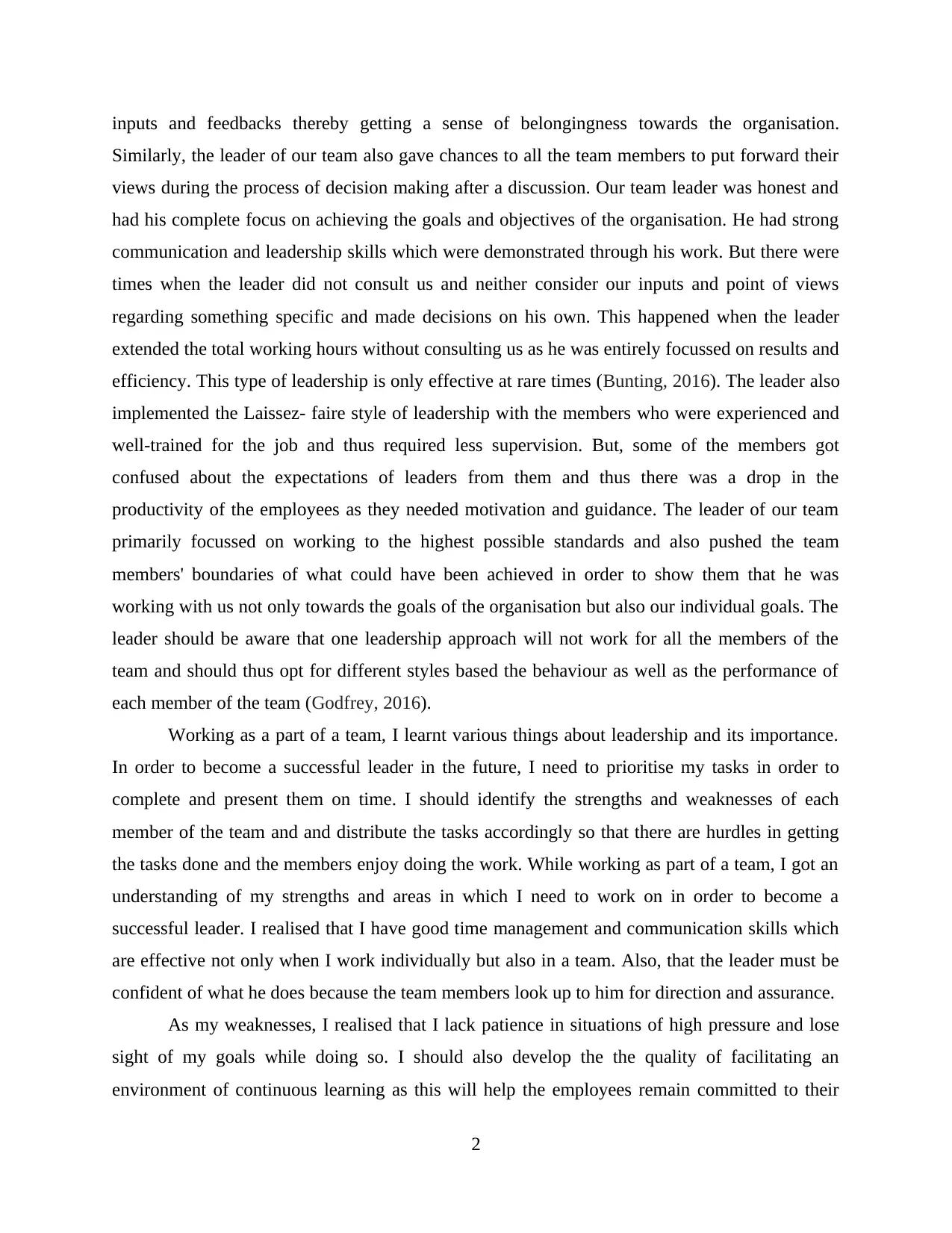
inputs and feedbacks thereby getting a sense of belongingness towards the organisation.
Similarly, the leader of our team also gave chances to all the team members to put forward their
views during the process of decision making after a discussion. Our team leader was honest and
had his complete focus on achieving the goals and objectives of the organisation. He had strong
communication and leadership skills which were demonstrated through his work. But there were
times when the leader did not consult us and neither consider our inputs and point of views
regarding something specific and made decisions on his own. This happened when the leader
extended the total working hours without consulting us as he was entirely focussed on results and
efficiency. This type of leadership is only effective at rare times (Bunting, 2016). The leader also
implemented the Laissez- faire style of leadership with the members who were experienced and
well-trained for the job and thus required less supervision. But, some of the members got
confused about the expectations of leaders from them and thus there was a drop in the
productivity of the employees as they needed motivation and guidance. The leader of our team
primarily focussed on working to the highest possible standards and also pushed the team
members' boundaries of what could have been achieved in order to show them that he was
working with us not only towards the goals of the organisation but also our individual goals. The
leader should be aware that one leadership approach will not work for all the members of the
team and should thus opt for different styles based the behaviour as well as the performance of
each member of the team (Godfrey, 2016).
Working as a part of a team, I learnt various things about leadership and its importance.
In order to become a successful leader in the future, I need to prioritise my tasks in order to
complete and present them on time. I should identify the strengths and weaknesses of each
member of the team and and distribute the tasks accordingly so that there are hurdles in getting
the tasks done and the members enjoy doing the work. While working as part of a team, I got an
understanding of my strengths and areas in which I need to work on in order to become a
successful leader. I realised that I have good time management and communication skills which
are effective not only when I work individually but also in a team. Also, that the leader must be
confident of what he does because the team members look up to him for direction and assurance.
As my weaknesses, I realised that I lack patience in situations of high pressure and lose
sight of my goals while doing so. I should also develop the the quality of facilitating an
environment of continuous learning as this will help the employees remain committed to their
2
Similarly, the leader of our team also gave chances to all the team members to put forward their
views during the process of decision making after a discussion. Our team leader was honest and
had his complete focus on achieving the goals and objectives of the organisation. He had strong
communication and leadership skills which were demonstrated through his work. But there were
times when the leader did not consult us and neither consider our inputs and point of views
regarding something specific and made decisions on his own. This happened when the leader
extended the total working hours without consulting us as he was entirely focussed on results and
efficiency. This type of leadership is only effective at rare times (Bunting, 2016). The leader also
implemented the Laissez- faire style of leadership with the members who were experienced and
well-trained for the job and thus required less supervision. But, some of the members got
confused about the expectations of leaders from them and thus there was a drop in the
productivity of the employees as they needed motivation and guidance. The leader of our team
primarily focussed on working to the highest possible standards and also pushed the team
members' boundaries of what could have been achieved in order to show them that he was
working with us not only towards the goals of the organisation but also our individual goals. The
leader should be aware that one leadership approach will not work for all the members of the
team and should thus opt for different styles based the behaviour as well as the performance of
each member of the team (Godfrey, 2016).
Working as a part of a team, I learnt various things about leadership and its importance.
In order to become a successful leader in the future, I need to prioritise my tasks in order to
complete and present them on time. I should identify the strengths and weaknesses of each
member of the team and and distribute the tasks accordingly so that there are hurdles in getting
the tasks done and the members enjoy doing the work. While working as part of a team, I got an
understanding of my strengths and areas in which I need to work on in order to become a
successful leader. I realised that I have good time management and communication skills which
are effective not only when I work individually but also in a team. Also, that the leader must be
confident of what he does because the team members look up to him for direction and assurance.
As my weaknesses, I realised that I lack patience in situations of high pressure and lose
sight of my goals while doing so. I should also develop the the quality of facilitating an
environment of continuous learning as this will help the employees remain committed to their
2
Paraphrase This Document
Need a fresh take? Get an instant paraphrase of this document with our AI Paraphraser
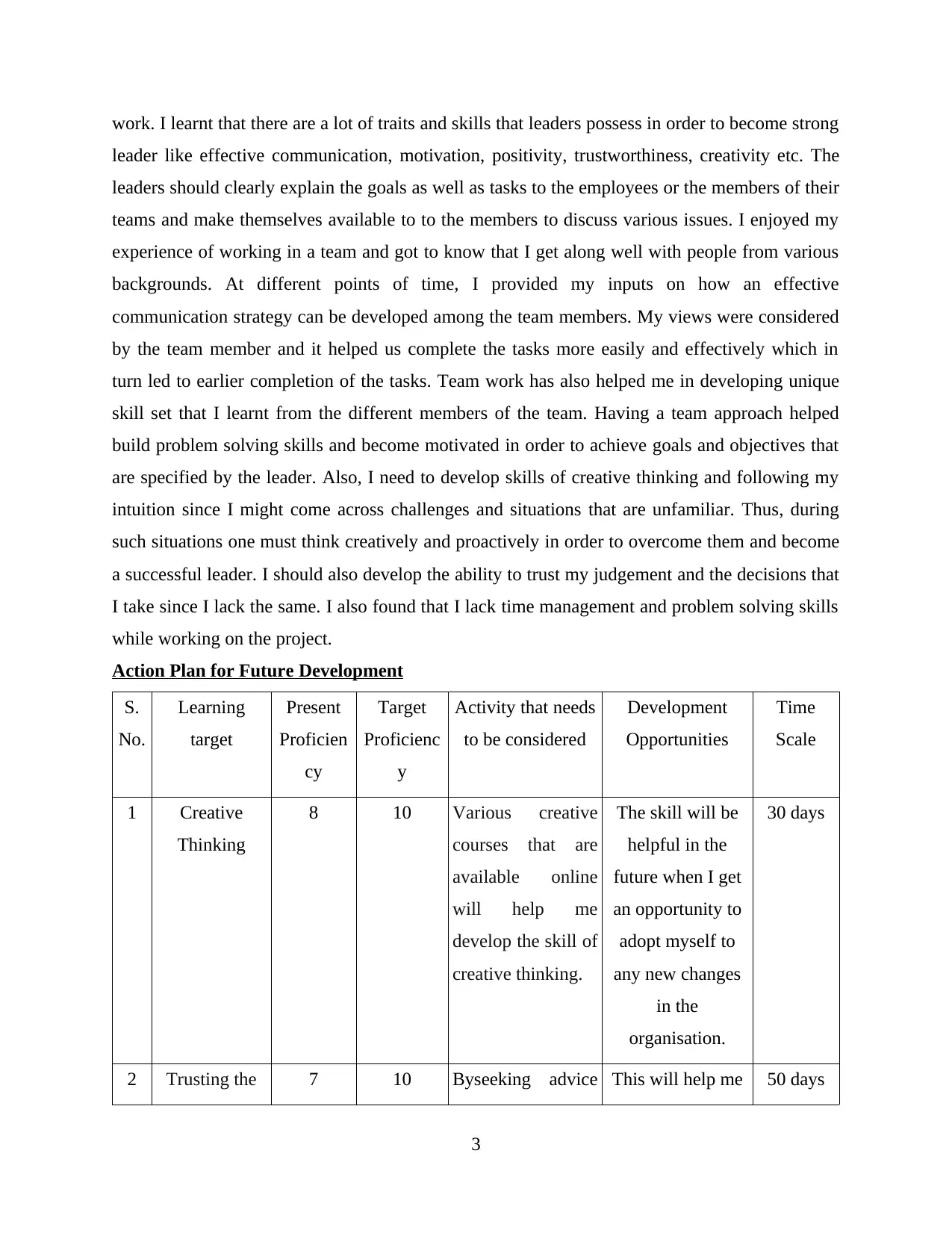
work. I learnt that there are a lot of traits and skills that leaders possess in order to become strong
leader like effective communication, motivation, positivity, trustworthiness, creativity etc. The
leaders should clearly explain the goals as well as tasks to the employees or the members of their
teams and make themselves available to to the members to discuss various issues. I enjoyed my
experience of working in a team and got to know that I get along well with people from various
backgrounds. At different points of time, I provided my inputs on how an effective
communication strategy can be developed among the team members. My views were considered
by the team member and it helped us complete the tasks more easily and effectively which in
turn led to earlier completion of the tasks. Team work has also helped me in developing unique
skill set that I learnt from the different members of the team. Having a team approach helped
build problem solving skills and become motivated in order to achieve goals and objectives that
are specified by the leader. Also, I need to develop skills of creative thinking and following my
intuition since I might come across challenges and situations that are unfamiliar. Thus, during
such situations one must think creatively and proactively in order to overcome them and become
a successful leader. I should also develop the ability to trust my judgement and the decisions that
I take since I lack the same. I also found that I lack time management and problem solving skills
while working on the project.
Action Plan for Future Development
S.
No.
Learning
target
Present
Proficien
cy
Target
Proficienc
y
Activity that needs
to be considered
Development
Opportunities
Time
Scale
1 Creative
Thinking
8 10 Various creative
courses that are
available online
will help me
develop the skill of
creative thinking.
The skill will be
helpful in the
future when I get
an opportunity to
adopt myself to
any new changes
in the
organisation.
30 days
2 Trusting the 7 10 Byseeking advice This will help me 50 days
3
leader like effective communication, motivation, positivity, trustworthiness, creativity etc. The
leaders should clearly explain the goals as well as tasks to the employees or the members of their
teams and make themselves available to to the members to discuss various issues. I enjoyed my
experience of working in a team and got to know that I get along well with people from various
backgrounds. At different points of time, I provided my inputs on how an effective
communication strategy can be developed among the team members. My views were considered
by the team member and it helped us complete the tasks more easily and effectively which in
turn led to earlier completion of the tasks. Team work has also helped me in developing unique
skill set that I learnt from the different members of the team. Having a team approach helped
build problem solving skills and become motivated in order to achieve goals and objectives that
are specified by the leader. Also, I need to develop skills of creative thinking and following my
intuition since I might come across challenges and situations that are unfamiliar. Thus, during
such situations one must think creatively and proactively in order to overcome them and become
a successful leader. I should also develop the ability to trust my judgement and the decisions that
I take since I lack the same. I also found that I lack time management and problem solving skills
while working on the project.
Action Plan for Future Development
S.
No.
Learning
target
Present
Proficien
cy
Target
Proficienc
y
Activity that needs
to be considered
Development
Opportunities
Time
Scale
1 Creative
Thinking
8 10 Various creative
courses that are
available online
will help me
develop the skill of
creative thinking.
The skill will be
helpful in the
future when I get
an opportunity to
adopt myself to
any new changes
in the
organisation.
30 days
2 Trusting the 7 10 Byseeking advice This will help me 50 days
3
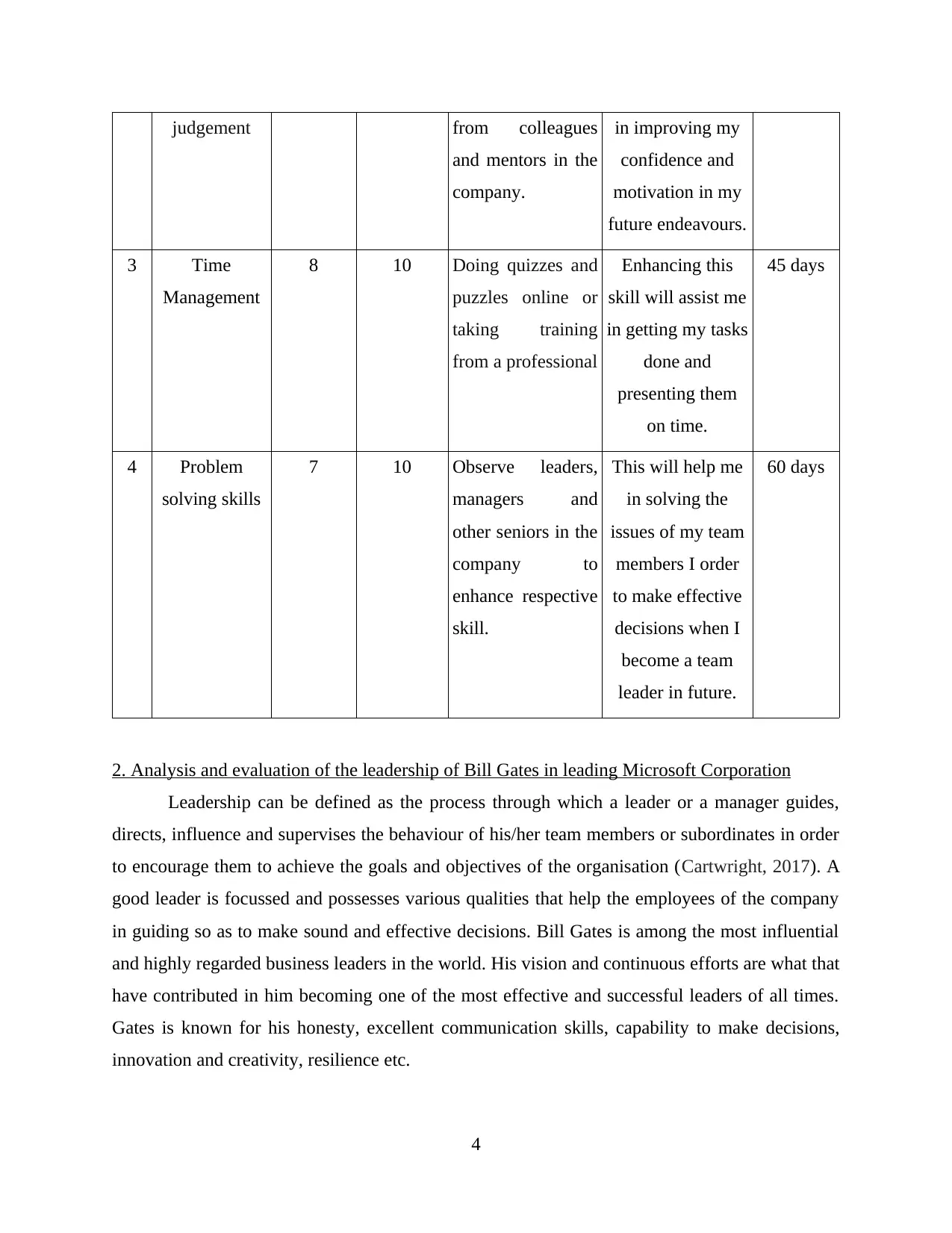
judgement from colleagues
and mentors in the
company.
in improving my
confidence and
motivation in my
future endeavours.
3 Time
Management
8 10 Doing quizzes and
puzzles online or
taking training
from a professional
Enhancing this
skill will assist me
in getting my tasks
done and
presenting them
on time.
45 days
4 Problem
solving skills
7 10 Observe leaders,
managers and
other seniors in the
company to
enhance respective
skill.
This will help me
in solving the
issues of my team
members I order
to make effective
decisions when I
become a team
leader in future.
60 days
2. Analysis and evaluation of the leadership of Bill Gates in leading Microsoft Corporation
Leadership can be defined as the process through which a leader or a manager guides,
directs, influence and supervises the behaviour of his/her team members or subordinates in order
to encourage them to achieve the goals and objectives of the organisation (Cartwright, 2017). A
good leader is focussed and possesses various qualities that help the employees of the company
in guiding so as to make sound and effective decisions. Bill Gates is among the most influential
and highly regarded business leaders in the world. His vision and continuous efforts are what that
have contributed in him becoming one of the most effective and successful leaders of all times.
Gates is known for his honesty, excellent communication skills, capability to make decisions,
innovation and creativity, resilience etc.
4
and mentors in the
company.
in improving my
confidence and
motivation in my
future endeavours.
3 Time
Management
8 10 Doing quizzes and
puzzles online or
taking training
from a professional
Enhancing this
skill will assist me
in getting my tasks
done and
presenting them
on time.
45 days
4 Problem
solving skills
7 10 Observe leaders,
managers and
other seniors in the
company to
enhance respective
skill.
This will help me
in solving the
issues of my team
members I order
to make effective
decisions when I
become a team
leader in future.
60 days
2. Analysis and evaluation of the leadership of Bill Gates in leading Microsoft Corporation
Leadership can be defined as the process through which a leader or a manager guides,
directs, influence and supervises the behaviour of his/her team members or subordinates in order
to encourage them to achieve the goals and objectives of the organisation (Cartwright, 2017). A
good leader is focussed and possesses various qualities that help the employees of the company
in guiding so as to make sound and effective decisions. Bill Gates is among the most influential
and highly regarded business leaders in the world. His vision and continuous efforts are what that
have contributed in him becoming one of the most effective and successful leaders of all times.
Gates is known for his honesty, excellent communication skills, capability to make decisions,
innovation and creativity, resilience etc.
4
⊘ This is a preview!⊘
Do you want full access?
Subscribe today to unlock all pages.

Trusted by 1+ million students worldwide
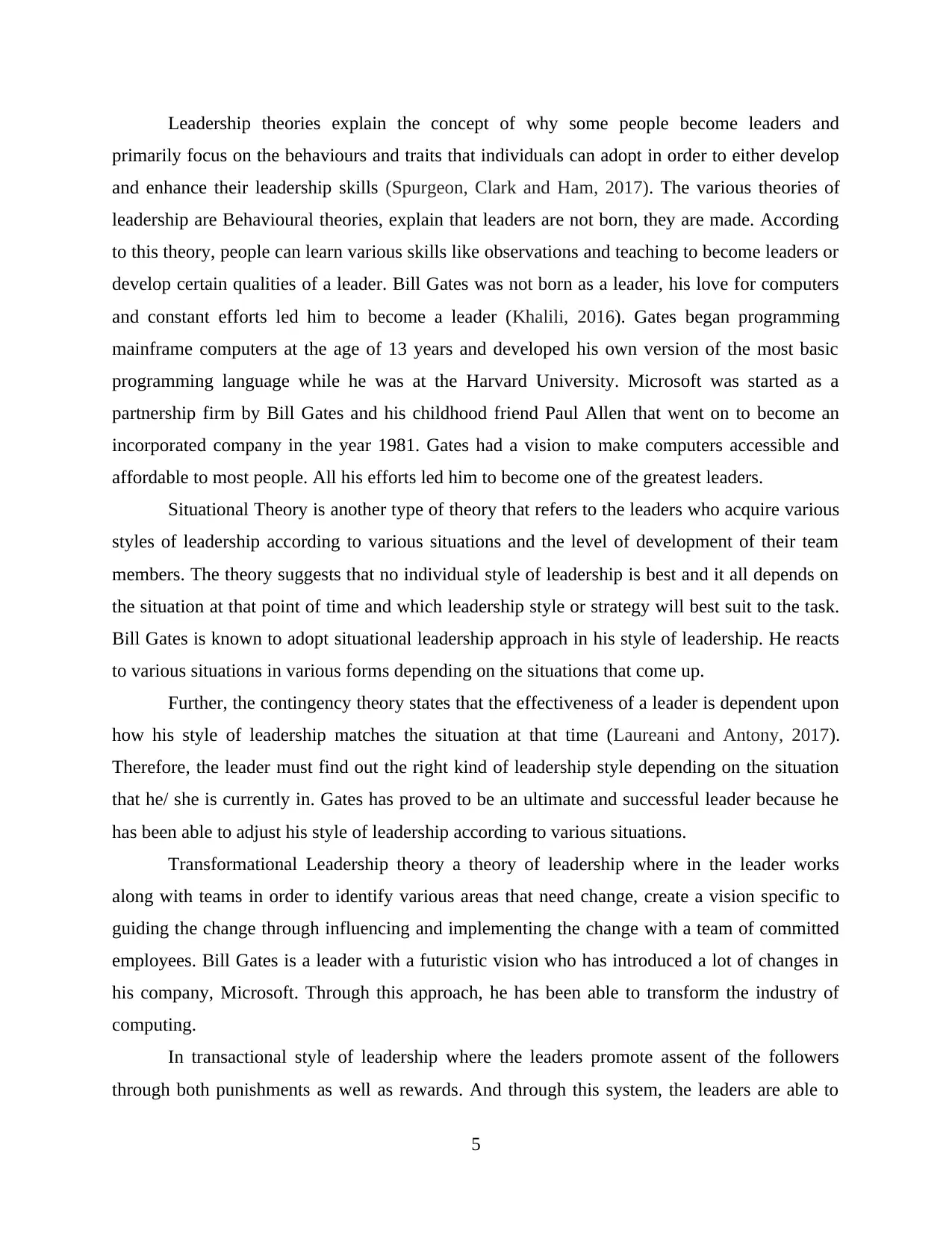
Leadership theories explain the concept of why some people become leaders and
primarily focus on the behaviours and traits that individuals can adopt in order to either develop
and enhance their leadership skills (Spurgeon, Clark and Ham, 2017). The various theories of
leadership are Behavioural theories, explain that leaders are not born, they are made. According
to this theory, people can learn various skills like observations and teaching to become leaders or
develop certain qualities of a leader. Bill Gates was not born as a leader, his love for computers
and constant efforts led him to become a leader (Khalili, 2016). Gates began programming
mainframe computers at the age of 13 years and developed his own version of the most basic
programming language while he was at the Harvard University. Microsoft was started as a
partnership firm by Bill Gates and his childhood friend Paul Allen that went on to become an
incorporated company in the year 1981. Gates had a vision to make computers accessible and
affordable to most people. All his efforts led him to become one of the greatest leaders.
Situational Theory is another type of theory that refers to the leaders who acquire various
styles of leadership according to various situations and the level of development of their team
members. The theory suggests that no individual style of leadership is best and it all depends on
the situation at that point of time and which leadership style or strategy will best suit to the task.
Bill Gates is known to adopt situational leadership approach in his style of leadership. He reacts
to various situations in various forms depending on the situations that come up.
Further, the contingency theory states that the effectiveness of a leader is dependent upon
how his style of leadership matches the situation at that time (Laureani and Antony, 2017).
Therefore, the leader must find out the right kind of leadership style depending on the situation
that he/ she is currently in. Gates has proved to be an ultimate and successful leader because he
has been able to adjust his style of leadership according to various situations.
Transformational Leadership theory a theory of leadership where in the leader works
along with teams in order to identify various areas that need change, create a vision specific to
guiding the change through influencing and implementing the change with a team of committed
employees. Bill Gates is a leader with a futuristic vision who has introduced a lot of changes in
his company, Microsoft. Through this approach, he has been able to transform the industry of
computing.
In transactional style of leadership where the leaders promote assent of the followers
through both punishments as well as rewards. And through this system, the leaders are able to
5
primarily focus on the behaviours and traits that individuals can adopt in order to either develop
and enhance their leadership skills (Spurgeon, Clark and Ham, 2017). The various theories of
leadership are Behavioural theories, explain that leaders are not born, they are made. According
to this theory, people can learn various skills like observations and teaching to become leaders or
develop certain qualities of a leader. Bill Gates was not born as a leader, his love for computers
and constant efforts led him to become a leader (Khalili, 2016). Gates began programming
mainframe computers at the age of 13 years and developed his own version of the most basic
programming language while he was at the Harvard University. Microsoft was started as a
partnership firm by Bill Gates and his childhood friend Paul Allen that went on to become an
incorporated company in the year 1981. Gates had a vision to make computers accessible and
affordable to most people. All his efforts led him to become one of the greatest leaders.
Situational Theory is another type of theory that refers to the leaders who acquire various
styles of leadership according to various situations and the level of development of their team
members. The theory suggests that no individual style of leadership is best and it all depends on
the situation at that point of time and which leadership style or strategy will best suit to the task.
Bill Gates is known to adopt situational leadership approach in his style of leadership. He reacts
to various situations in various forms depending on the situations that come up.
Further, the contingency theory states that the effectiveness of a leader is dependent upon
how his style of leadership matches the situation at that time (Laureani and Antony, 2017).
Therefore, the leader must find out the right kind of leadership style depending on the situation
that he/ she is currently in. Gates has proved to be an ultimate and successful leader because he
has been able to adjust his style of leadership according to various situations.
Transformational Leadership theory a theory of leadership where in the leader works
along with teams in order to identify various areas that need change, create a vision specific to
guiding the change through influencing and implementing the change with a team of committed
employees. Bill Gates is a leader with a futuristic vision who has introduced a lot of changes in
his company, Microsoft. Through this approach, he has been able to transform the industry of
computing.
In transactional style of leadership where the leaders promote assent of the followers
through both punishments as well as rewards. And through this system, the leaders are able to
5
Paraphrase This Document
Need a fresh take? Get an instant paraphrase of this document with our AI Paraphraser
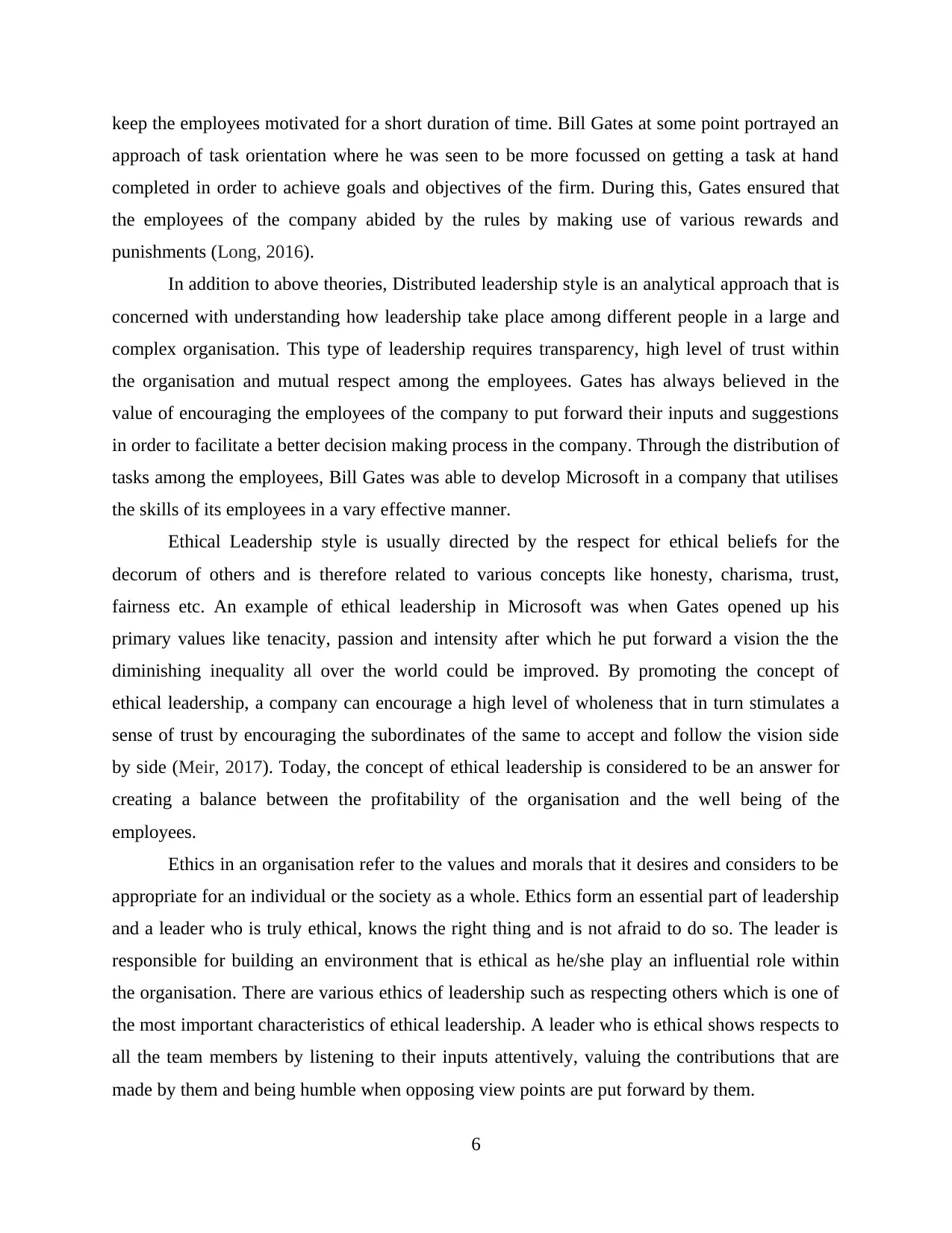
keep the employees motivated for a short duration of time. Bill Gates at some point portrayed an
approach of task orientation where he was seen to be more focussed on getting a task at hand
completed in order to achieve goals and objectives of the firm. During this, Gates ensured that
the employees of the company abided by the rules by making use of various rewards and
punishments (Long, 2016).
In addition to above theories, Distributed leadership style is an analytical approach that is
concerned with understanding how leadership take place among different people in a large and
complex organisation. This type of leadership requires transparency, high level of trust within
the organisation and mutual respect among the employees. Gates has always believed in the
value of encouraging the employees of the company to put forward their inputs and suggestions
in order to facilitate a better decision making process in the company. Through the distribution of
tasks among the employees, Bill Gates was able to develop Microsoft in a company that utilises
the skills of its employees in a vary effective manner.
Ethical Leadership style is usually directed by the respect for ethical beliefs for the
decorum of others and is therefore related to various concepts like honesty, charisma, trust,
fairness etc. An example of ethical leadership in Microsoft was when Gates opened up his
primary values like tenacity, passion and intensity after which he put forward a vision the the
diminishing inequality all over the world could be improved. By promoting the concept of
ethical leadership, a company can encourage a high level of wholeness that in turn stimulates a
sense of trust by encouraging the subordinates of the same to accept and follow the vision side
by side (Meir, 2017). Today, the concept of ethical leadership is considered to be an answer for
creating a balance between the profitability of the organisation and the well being of the
employees.
Ethics in an organisation refer to the values and morals that it desires and considers to be
appropriate for an individual or the society as a whole. Ethics form an essential part of leadership
and a leader who is truly ethical, knows the right thing and is not afraid to do so. The leader is
responsible for building an environment that is ethical as he/she play an influential role within
the organisation. There are various ethics of leadership such as respecting others which is one of
the most important characteristics of ethical leadership. A leader who is ethical shows respects to
all the team members by listening to their inputs attentively, valuing the contributions that are
made by them and being humble when opposing view points are put forward by them.
6
approach of task orientation where he was seen to be more focussed on getting a task at hand
completed in order to achieve goals and objectives of the firm. During this, Gates ensured that
the employees of the company abided by the rules by making use of various rewards and
punishments (Long, 2016).
In addition to above theories, Distributed leadership style is an analytical approach that is
concerned with understanding how leadership take place among different people in a large and
complex organisation. This type of leadership requires transparency, high level of trust within
the organisation and mutual respect among the employees. Gates has always believed in the
value of encouraging the employees of the company to put forward their inputs and suggestions
in order to facilitate a better decision making process in the company. Through the distribution of
tasks among the employees, Bill Gates was able to develop Microsoft in a company that utilises
the skills of its employees in a vary effective manner.
Ethical Leadership style is usually directed by the respect for ethical beliefs for the
decorum of others and is therefore related to various concepts like honesty, charisma, trust,
fairness etc. An example of ethical leadership in Microsoft was when Gates opened up his
primary values like tenacity, passion and intensity after which he put forward a vision the the
diminishing inequality all over the world could be improved. By promoting the concept of
ethical leadership, a company can encourage a high level of wholeness that in turn stimulates a
sense of trust by encouraging the subordinates of the same to accept and follow the vision side
by side (Meir, 2017). Today, the concept of ethical leadership is considered to be an answer for
creating a balance between the profitability of the organisation and the well being of the
employees.
Ethics in an organisation refer to the values and morals that it desires and considers to be
appropriate for an individual or the society as a whole. Ethics form an essential part of leadership
and a leader who is truly ethical, knows the right thing and is not afraid to do so. The leader is
responsible for building an environment that is ethical as he/she play an influential role within
the organisation. There are various ethics of leadership such as respecting others which is one of
the most important characteristics of ethical leadership. A leader who is ethical shows respects to
all the team members by listening to their inputs attentively, valuing the contributions that are
made by them and being humble when opposing view points are put forward by them.
6
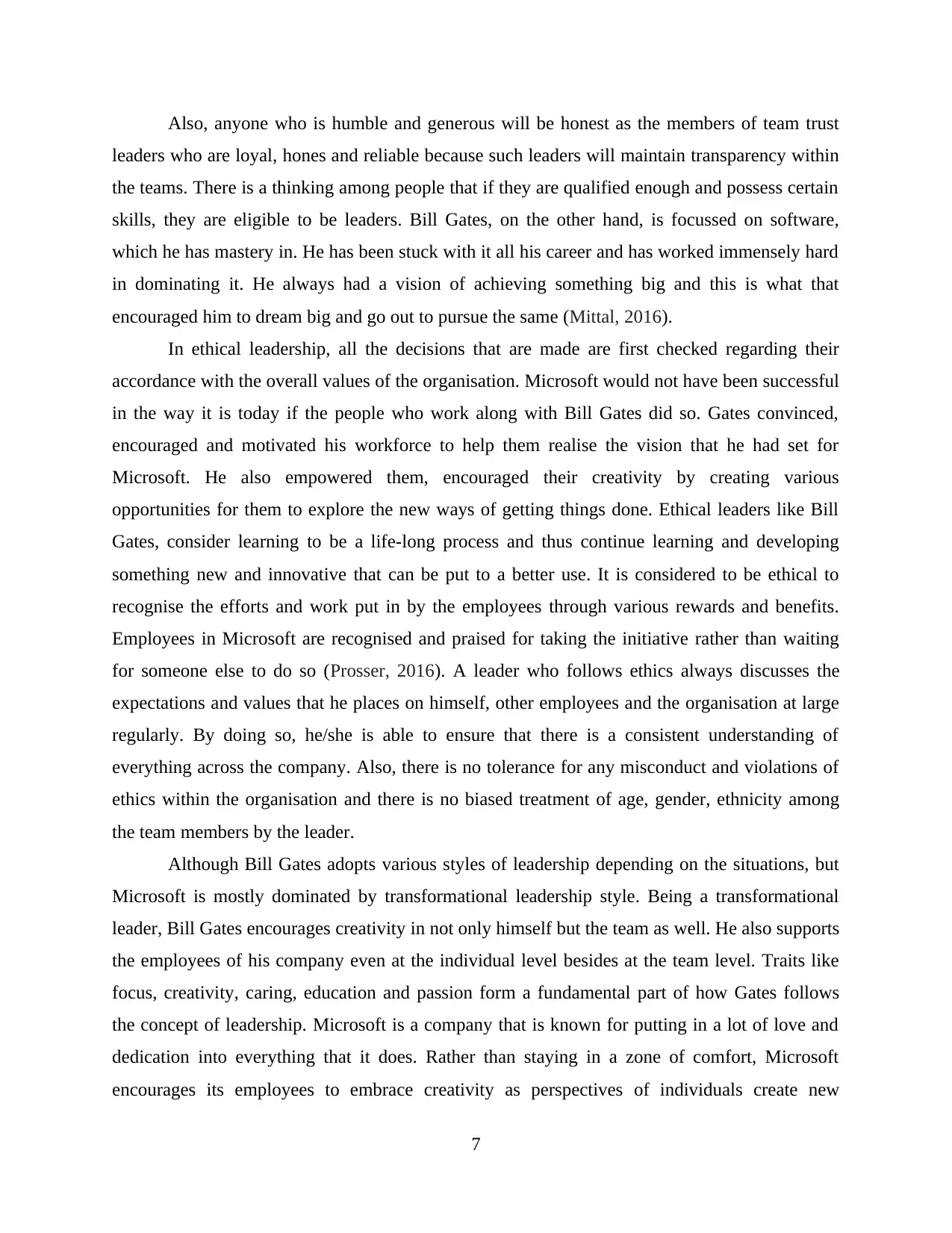
Also, anyone who is humble and generous will be honest as the members of team trust
leaders who are loyal, hones and reliable because such leaders will maintain transparency within
the teams. There is a thinking among people that if they are qualified enough and possess certain
skills, they are eligible to be leaders. Bill Gates, on the other hand, is focussed on software,
which he has mastery in. He has been stuck with it all his career and has worked immensely hard
in dominating it. He always had a vision of achieving something big and this is what that
encouraged him to dream big and go out to pursue the same (Mittal, 2016).
In ethical leadership, all the decisions that are made are first checked regarding their
accordance with the overall values of the organisation. Microsoft would not have been successful
in the way it is today if the people who work along with Bill Gates did so. Gates convinced,
encouraged and motivated his workforce to help them realise the vision that he had set for
Microsoft. He also empowered them, encouraged their creativity by creating various
opportunities for them to explore the new ways of getting things done. Ethical leaders like Bill
Gates, consider learning to be a life-long process and thus continue learning and developing
something new and innovative that can be put to a better use. It is considered to be ethical to
recognise the efforts and work put in by the employees through various rewards and benefits.
Employees in Microsoft are recognised and praised for taking the initiative rather than waiting
for someone else to do so (Prosser, 2016). A leader who follows ethics always discusses the
expectations and values that he places on himself, other employees and the organisation at large
regularly. By doing so, he/she is able to ensure that there is a consistent understanding of
everything across the company. Also, there is no tolerance for any misconduct and violations of
ethics within the organisation and there is no biased treatment of age, gender, ethnicity among
the team members by the leader.
Although Bill Gates adopts various styles of leadership depending on the situations, but
Microsoft is mostly dominated by transformational leadership style. Being a transformational
leader, Bill Gates encourages creativity in not only himself but the team as well. He also supports
the employees of his company even at the individual level besides at the team level. Traits like
focus, creativity, caring, education and passion form a fundamental part of how Gates follows
the concept of leadership. Microsoft is a company that is known for putting in a lot of love and
dedication into everything that it does. Rather than staying in a zone of comfort, Microsoft
encourages its employees to embrace creativity as perspectives of individuals create new
7
leaders who are loyal, hones and reliable because such leaders will maintain transparency within
the teams. There is a thinking among people that if they are qualified enough and possess certain
skills, they are eligible to be leaders. Bill Gates, on the other hand, is focussed on software,
which he has mastery in. He has been stuck with it all his career and has worked immensely hard
in dominating it. He always had a vision of achieving something big and this is what that
encouraged him to dream big and go out to pursue the same (Mittal, 2016).
In ethical leadership, all the decisions that are made are first checked regarding their
accordance with the overall values of the organisation. Microsoft would not have been successful
in the way it is today if the people who work along with Bill Gates did so. Gates convinced,
encouraged and motivated his workforce to help them realise the vision that he had set for
Microsoft. He also empowered them, encouraged their creativity by creating various
opportunities for them to explore the new ways of getting things done. Ethical leaders like Bill
Gates, consider learning to be a life-long process and thus continue learning and developing
something new and innovative that can be put to a better use. It is considered to be ethical to
recognise the efforts and work put in by the employees through various rewards and benefits.
Employees in Microsoft are recognised and praised for taking the initiative rather than waiting
for someone else to do so (Prosser, 2016). A leader who follows ethics always discusses the
expectations and values that he places on himself, other employees and the organisation at large
regularly. By doing so, he/she is able to ensure that there is a consistent understanding of
everything across the company. Also, there is no tolerance for any misconduct and violations of
ethics within the organisation and there is no biased treatment of age, gender, ethnicity among
the team members by the leader.
Although Bill Gates adopts various styles of leadership depending on the situations, but
Microsoft is mostly dominated by transformational leadership style. Being a transformational
leader, Bill Gates encourages creativity in not only himself but the team as well. He also supports
the employees of his company even at the individual level besides at the team level. Traits like
focus, creativity, caring, education and passion form a fundamental part of how Gates follows
the concept of leadership. Microsoft is a company that is known for putting in a lot of love and
dedication into everything that it does. Rather than staying in a zone of comfort, Microsoft
encourages its employees to embrace creativity as perspectives of individuals create new
7
⊘ This is a preview!⊘
Do you want full access?
Subscribe today to unlock all pages.

Trusted by 1+ million students worldwide
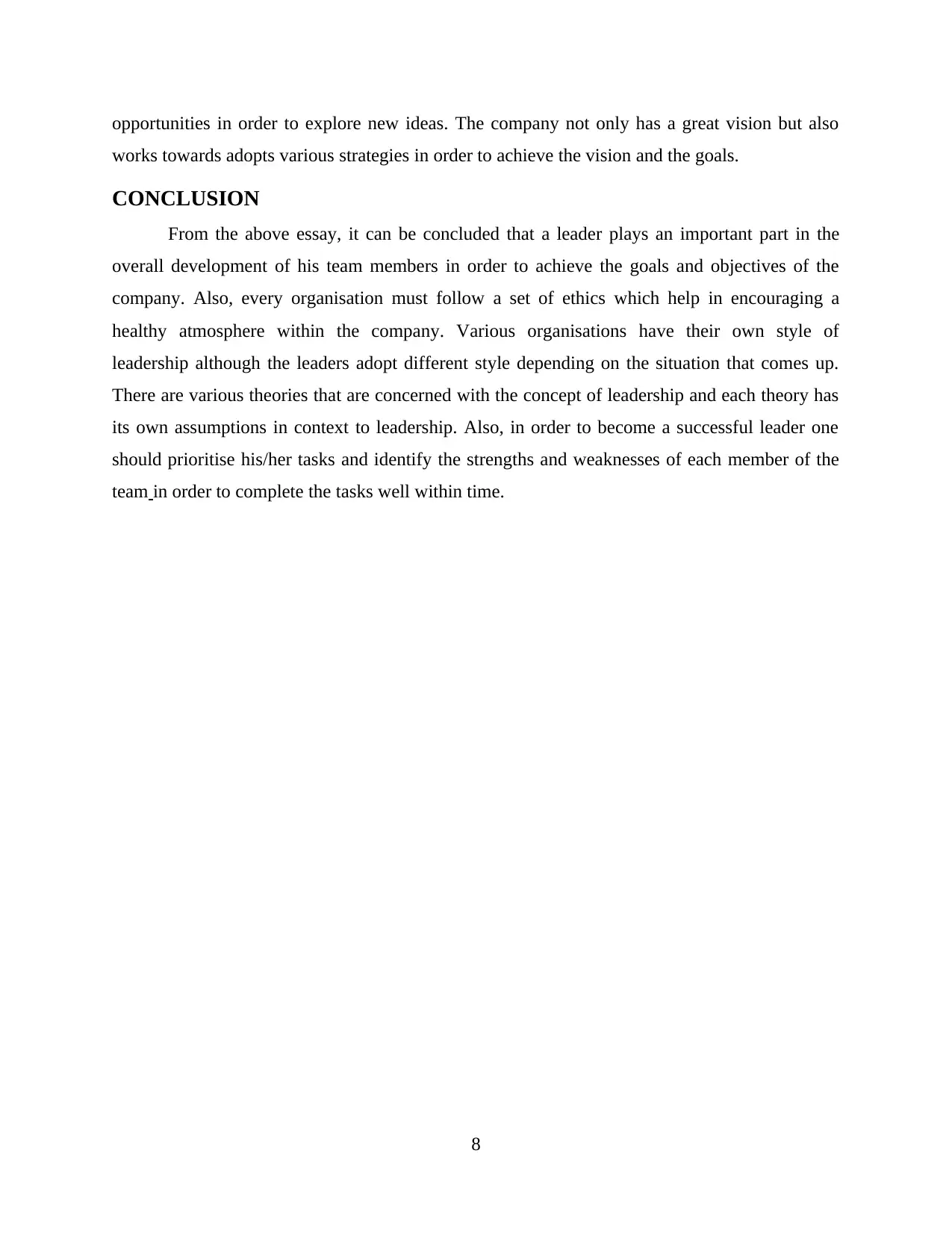
opportunities in order to explore new ideas. The company not only has a great vision but also
works towards adopts various strategies in order to achieve the vision and the goals.
CONCLUSION
From the above essay, it can be concluded that a leader plays an important part in the
overall development of his team members in order to achieve the goals and objectives of the
company. Also, every organisation must follow a set of ethics which help in encouraging a
healthy atmosphere within the company. Various organisations have their own style of
leadership although the leaders adopt different style depending on the situation that comes up.
There are various theories that are concerned with the concept of leadership and each theory has
its own assumptions in context to leadership. Also, in order to become a successful leader one
should prioritise his/her tasks and identify the strengths and weaknesses of each member of the
team in order to complete the tasks well within time.
8
works towards adopts various strategies in order to achieve the vision and the goals.
CONCLUSION
From the above essay, it can be concluded that a leader plays an important part in the
overall development of his team members in order to achieve the goals and objectives of the
company. Also, every organisation must follow a set of ethics which help in encouraging a
healthy atmosphere within the company. Various organisations have their own style of
leadership although the leaders adopt different style depending on the situation that comes up.
There are various theories that are concerned with the concept of leadership and each theory has
its own assumptions in context to leadership. Also, in order to become a successful leader one
should prioritise his/her tasks and identify the strengths and weaknesses of each member of the
team in order to complete the tasks well within time.
8
Paraphrase This Document
Need a fresh take? Get an instant paraphrase of this document with our AI Paraphraser
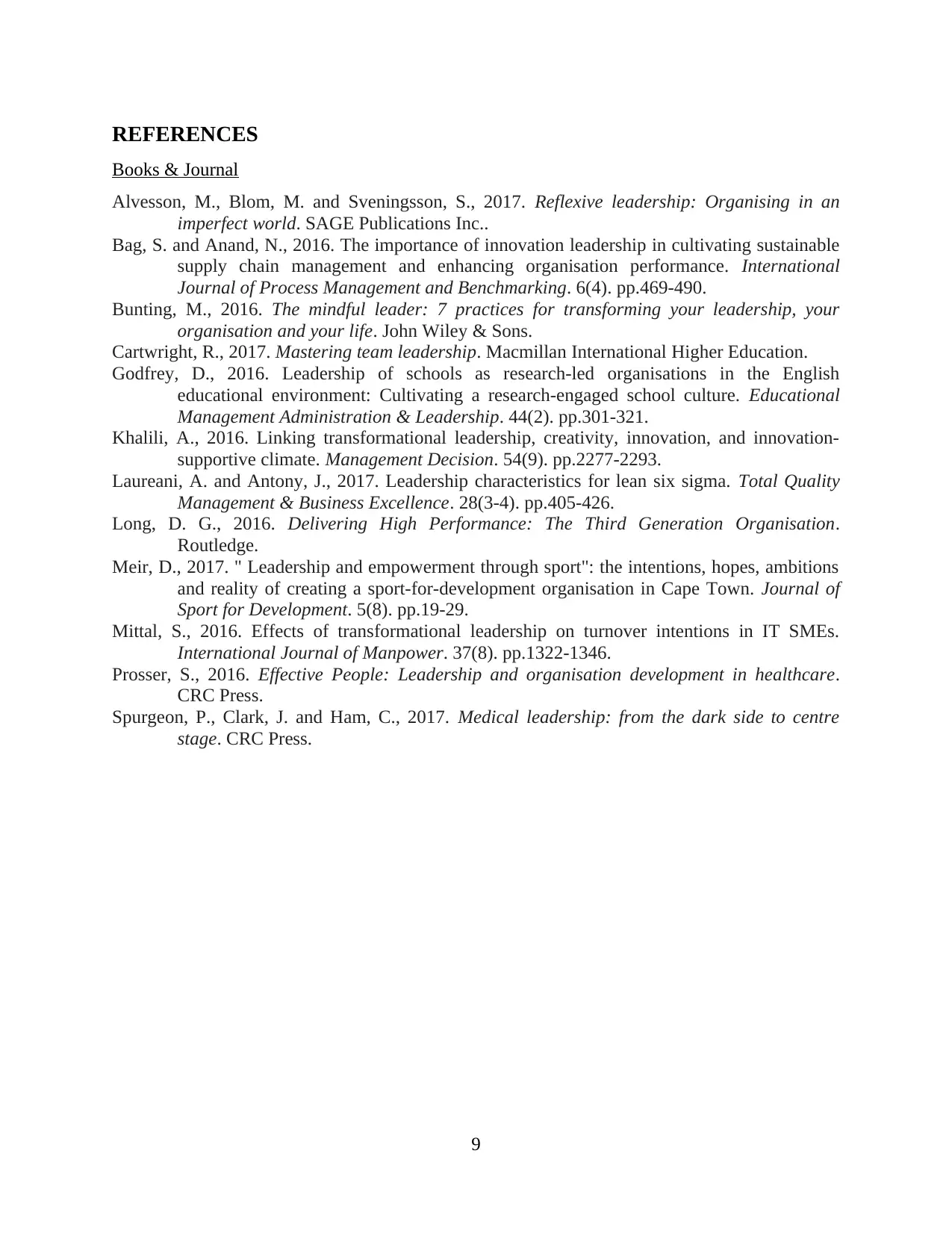
REFERENCES
Books & Journal
Alvesson, M., Blom, M. and Sveningsson, S., 2017. Reflexive leadership: Organising in an
imperfect world. SAGE Publications Inc..
Bag, S. and Anand, N., 2016. The importance of innovation leadership in cultivating sustainable
supply chain management and enhancing organisation performance. International
Journal of Process Management and Benchmarking. 6(4). pp.469-490.
Bunting, M., 2016. The mindful leader: 7 practices for transforming your leadership, your
organisation and your life. John Wiley & Sons.
Cartwright, R., 2017. Mastering team leadership. Macmillan International Higher Education.
Godfrey, D., 2016. Leadership of schools as research-led organisations in the English
educational environment: Cultivating a research-engaged school culture. Educational
Management Administration & Leadership. 44(2). pp.301-321.
Khalili, A., 2016. Linking transformational leadership, creativity, innovation, and innovation-
supportive climate. Management Decision. 54(9). pp.2277-2293.
Laureani, A. and Antony, J., 2017. Leadership characteristics for lean six sigma. Total Quality
Management & Business Excellence. 28(3-4). pp.405-426.
Long, D. G., 2016. Delivering High Performance: The Third Generation Organisation.
Routledge.
Meir, D., 2017. " Leadership and empowerment through sport": the intentions, hopes, ambitions
and reality of creating a sport-for-development organisation in Cape Town. Journal of
Sport for Development. 5(8). pp.19-29.
Mittal, S., 2016. Effects of transformational leadership on turnover intentions in IT SMEs.
International Journal of Manpower. 37(8). pp.1322-1346.
Prosser, S., 2016. Effective People: Leadership and organisation development in healthcare.
CRC Press.
Spurgeon, P., Clark, J. and Ham, C., 2017. Medical leadership: from the dark side to centre
stage. CRC Press.
9
Books & Journal
Alvesson, M., Blom, M. and Sveningsson, S., 2017. Reflexive leadership: Organising in an
imperfect world. SAGE Publications Inc..
Bag, S. and Anand, N., 2016. The importance of innovation leadership in cultivating sustainable
supply chain management and enhancing organisation performance. International
Journal of Process Management and Benchmarking. 6(4). pp.469-490.
Bunting, M., 2016. The mindful leader: 7 practices for transforming your leadership, your
organisation and your life. John Wiley & Sons.
Cartwright, R., 2017. Mastering team leadership. Macmillan International Higher Education.
Godfrey, D., 2016. Leadership of schools as research-led organisations in the English
educational environment: Cultivating a research-engaged school culture. Educational
Management Administration & Leadership. 44(2). pp.301-321.
Khalili, A., 2016. Linking transformational leadership, creativity, innovation, and innovation-
supportive climate. Management Decision. 54(9). pp.2277-2293.
Laureani, A. and Antony, J., 2017. Leadership characteristics for lean six sigma. Total Quality
Management & Business Excellence. 28(3-4). pp.405-426.
Long, D. G., 2016. Delivering High Performance: The Third Generation Organisation.
Routledge.
Meir, D., 2017. " Leadership and empowerment through sport": the intentions, hopes, ambitions
and reality of creating a sport-for-development organisation in Cape Town. Journal of
Sport for Development. 5(8). pp.19-29.
Mittal, S., 2016. Effects of transformational leadership on turnover intentions in IT SMEs.
International Journal of Manpower. 37(8). pp.1322-1346.
Prosser, S., 2016. Effective People: Leadership and organisation development in healthcare.
CRC Press.
Spurgeon, P., Clark, J. and Ham, C., 2017. Medical leadership: from the dark side to centre
stage. CRC Press.
9
1 out of 11
Related Documents
Your All-in-One AI-Powered Toolkit for Academic Success.
+13062052269
info@desklib.com
Available 24*7 on WhatsApp / Email
![[object Object]](/_next/static/media/star-bottom.7253800d.svg)
Unlock your academic potential
Copyright © 2020–2025 A2Z Services. All Rights Reserved. Developed and managed by ZUCOL.
![Leadership and Management Reflection Report - [Course Name]](/_next/image/?url=https%3A%2F%2Fdesklib.com%2Fmedia%2Fimages%2Ftd%2F609a50cd4c7044d196b9d89d4e436278.jpg&w=256&q=75)




